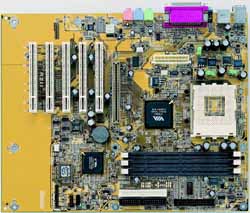FIC was one of the first manufacturers to have a Slot-A Athlon motherboard at the release of that CPU with their SD-11. They were the first to deviate from the AMD reference design and even used a hybrid chipset consisting of the AMD 750 North Bridge + VIA 686A South Bridge. The use of the VIA South Bridge was not a major surprise given FIC's tight relationship with VIA. The SD-11 was far from perfect when we first looked at a prerelease, but a few revisions later everything seemed to be working smoothly.
It's no surprise that FIC is once again one of the first with a Socket-A motherboard, the AZ-11, to go along with the release of the Socket-A based Thunderbird and Duron. In fact, AMD's evaluation systems used a special version of the AZ-11. What was special about this AZ-11? It was actually an OEM version designed for Compaq, which of course featured a custom Compaq OEM BIOS. Compaq's faith in FIC and their AZ-11 speaks volumes for what FIC has been able to do in the market. Even Kryotech was using the AZ-11 at Computex to demo their latest system, a 1.4 GHz Thunderbird. That also speaks volumes for the AZ-11's stability. Nevertheless, we know that AnandTech readers, Compaq, and Kryotech all look for different things when it comes time to shop for a motherboard. Let's see how the AZ-11 stands up under the AnandTech microscope.
|
Motherboard Specifications |
|
| CPU Interface |
Socket-A
|
| Chipset |
VIA KT133
|
| Form Factor |
ATX
|
| Bus Speeds |
100
/ 102 / 104 / 106 / 107
109 / 110 / 111 / 112 / 133 |
| Voltages Supported |
Auto Detect
|
| Memory Slots |
3 168-pin DIMM Slots
|
| Expansion Slots |
1 AGP Slot
5 PCI Slots (5 Full Length) 0 AMR Slots 0 ISA Slots |
| Onboard Sound |
Sigmatel
STAC9744T AC 97 CODEC
|
| BIOS |
Award 6.00PG
|
The Good
The most obvious thing about the SD-11, FIC's first Athlon motherboard, was its monstrous PCB. It seems that the release of Socket-A CPU's from AMD has done little to change FIC's philosophy on large PCB's as the AZ-11 is virtually identical in size. When we looked at the SD-11, it seemed that there was no good reason for such a large PCB and that is the case with the AZ-11 as well as we've seen many motherboards with equivalent functionality, but in a much smaller package. Why does it matter? The most obvious reason is that it may not fit in some smaller cases, but just as important it increases the cost to manufacture the board, which is then passed on to the consumer. A brief look at various vendors on the web does indeed show the AZ-11 to be priced slightly higher than other Socket-A motherboards.
The 5/1/0/0 (PCI/AGP/ISA/AMR) expansion configuration is also noteworthy, not because it is especially useful, but because it is a bit of an odd decision. There's room for an additional PCI slot plus an additional AMR or ISA slot, but FIC has chosen to leave that PCB space empty, despite support for such slots in the VIA 686A Super South Bridge. It turns out that FIC is actually working on another version of the AZ-11 that will feature an additional PCI and/or ISA slot as well as an on-board firewire controller. Although, we're still a bit surprised that Compaq, one of the largest OEM's in the world that also happens to use the AZ-11 in their systems, would not want an AMR slot, something that was targeted specifically at OEM's.
Located between the Socket-A connector and the AGP slot is the KT133's North Bridge, covered by the good old green heatsink that motherboard manufacturers have been using since the days of the i440LX. The 8373 North Bridge is nearly identical to the 8371 of the KX133 with a few timing changes to support AMD's Socket-A CPU's. The AZ-11 is designed such that it can take advantage of the pin compatible 8365 North Bridge of the KM133, which is basically a KT133 chipset with the addition of integrated S3 Savage 4 graphics. For that reason, FIC had to make room for the VGA connector on the ATX backplane, which in turn means that a serial port is lost on both versions of the AZ-11. The KM133 version of the AZ-11 will most likely receive a different name to make the distinction in the market clear.
The North Bridge provides all the key features of the KT133/KM133, most importantly 133MHz memory bus and AGP 4X support. The beauty of the 8373's memory controller is that it can run your memory at either 133MHz or 100MHz using a multiplier of the FSB frequency. So those users with PC133 SDRAM can take advantage of the increased bandwidth (1.06GB/s vs. 800MB/s) over PC100 SDRAM, while allowing backwards compatibility with older PC100 SDRAM. Support for VC100/VC133 memory is still included, but availability is still weak and prices high.
The AZ-11, as is the case with most Athlon motherboards, features 3 DIMM slots capable of accepting PC100/PC133 or VC100/VC133 SDRAM running at either a 3:3 (1:1) ratio with the FSB (by default, 100MHz) or a 4:3 ratio with the FSB (133MHz by default). This is the recommended maximum for PC133 support according to VIA.











0 Comments
View All Comments